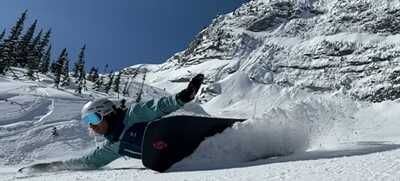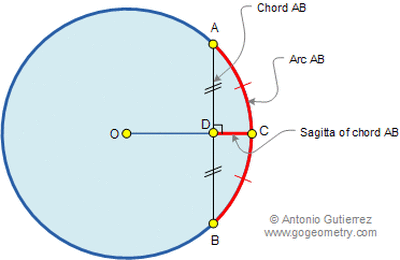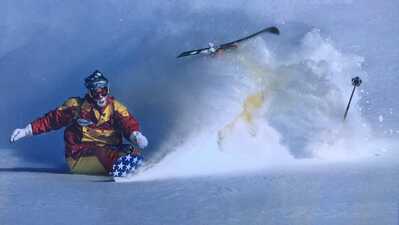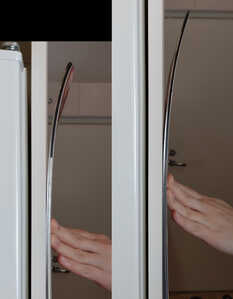Posted by: @AnonymousWill the JJA "Working Title" work for
someone like me?
It would definitely work for you. We have a couple of buyers who have asked for narrowed waists and we're gonna try and make sure they get what they need. Of course, they're all sold out but get on the wait list in the store and you'll know when we're taking orders for the next batch.
I'm just slaying...
Hot Blast has a 19.9cm waist, 25.5cm tip & 25.0cm tail with a 140cm effective edge, 160cm overall length. So 26.5mm depth to the arc.
But I have a Riot Supercarve from the late 1990's, 178cm long, 171cm effective edge, 17cm waist, 24.2 tip, 23.5 tail, for a depth just over 34mm.
Sidecut depth with a board lying flat is not what you get when the board is high on edge. The tip and tail twist away to a lower angle. You can see this effect in many photos of hardbooters high on edge in the linked thread below. The board looks bent in the middle but almost straight out beyond the bindings.
https://forums.alpinesnowboarder.com/topic/43232-bend-it/
Snow penetration to create the groove we carve in, and the lateral wall that supports us, is clearly the result of snow consistency and the downforce of the rider. The differences in forward facing tip area of the board where penetration occurs are tiny by comparison.
I had a long conversation with James Cherry when I was in Revelstoke in Feb 2023 about sidecut depth. James, like you, seemed to think it was important, but couldn't explain why to me. I'm interested to know how you understand its significance to performance.
I’m no expert, but I feel like more depth makes it a lot easier to tighten the radius. You just add angle and your weight/cornering force pushes the centre to the ground and bends the board more. It’s like shaped skis… sure the racers previously carved, but adding depth really helped novices start carving.
Big White, BC, Canada
These are a primer on snowboard turn shape. They were made 12 years ago and there are some factors that Sean ignores or skates over.
First, he treats a carved turn as happening on a flat but sloping carved surface, with no surface penetration. In fact a carved turn begins with snow surface penetration and then continued penetration by the leading edge of the board. The board base then rides on the lateral wall of the groove the board creates. (Sean briefly alludes to this in his defense of centrifugal force in the Appendix to Pt2) After a days carving the base of your board will show you that is what is happening. The wax will be polished away on the lateral 3-4cm of the base on both edges. Even on ice some surface penetration has to occur, otherwise there can be no grip. Ice skate blades are designed to carve on ice and cut a groove in the ice.
Initially, as the board tilt angle begins to rise sidecut creates the majority of the curve the edge is bent into, and which drives the nose of the board in a curve. But board designers are aware that the flex curve is important too. That is partly why modern race boards have small lengths of slight rocker at the very tip and tail, with cambered mid sections. (c.f. Kessler KST technology)
The rocker starts to create the turn curve the moment the board goes on to its edge and at the point where surface penetration is occurring. As the board gets higher and higher on edge, more and more of the turn shape is determined by the board flex. At 45 degrees flex and SCR are contributing roughly equally. As the board tilts higher flex starts to predominate in creating the curve that the lateral wall follows. Remember the board is riding on that lateral wall of the groove, and that is the surface against which the rider is supported. If the resultant vector of the forces acting on the rider move outside of that base of support the rider will fall.
Old style skis were called "straights" and had enormously long sidecuts. The rider had to flex them in order to get them to carve a turn, and as we've just seen you need high edge angles to create a lot of flex bend. Carving skis and snowboards are "shaped" and that sidecut helps initiate a carved turn at low edge angles. As I said in my original comment, sidecut depth is just the result of the sidecut radius and the effective edge. The turn shape is initially created by the radius of the board, not the depth of the sidecut.
Most people riding carving skis, and most people riding softboot snowboards get nowhere near 45 degrees of carving turn inclination. For them SCR and board angulation are their turn shape determinants. But watch James riding Pitch Black at Revy and see how high he routinely gets on edge.
Hardboot snowboard carvers routinely go higher than 45 degrees on steeper slopes.
Only expert skiers and ski racers get near those levels of inclination. And that is where James is aiming to take all the softbooters who come here!
We should probably have this side discussion in the other thread:
https://carversconnection.com/community/carving-technique/sidecut-radius/#post-481
I agree that the radius starts the turn... but I think the depth more easily decreases the radius with modest edge angle (many riders don't even get to 45deg). As you go to the extreme (90deg) you could even bend a straight sidecut into ANY radius that you want. I understand that flex becomes more important, particularly for extreme carving, but that's not how everyone always rides (myself included).
In the context of this JJA board, yes flex is important and I actually wouldn't want turns to tighten too much with speed and edge angle. On the other hand, the 6000 just wants to turn and I think it's an interesting option for a lot of people. It depends how you ride and what you want to do. Quivers are fun.
On edit, I see that you added the "most people..." bit. I think we're on the same page, just different perspectives.
Big White, BC, Canada
Posted by: @riotsupercarverI had a long conversation with James Cherry when I was in Revelstoke in Feb 2023 about sidecut depth. James, like you, seemed to think it was important, but couldn't explain why to me.
That's fair. I'm not sure about all the physics but I was smoking in my boardroom one night and for no particular reason started physically measuring the effective edge lengths on a most of my boards. I found a real strong correlation between sidecut depth and subjectively estimated turning radii. Coincidence?
Later I found this cool sidecut calculator: https://natewaddoups.github.io/SidecutCalculator.html and it made the job easier.
Earlier this season Lars Hostmann was discussing board shapes in a video I felt vindicated when he seemed to come to the same conclusion as I did independently. But after riding the Freecarver 6000 I've begun to question everything I know about snowboard shapes and sidecuts...
That was the 158cm right @board-doctor? Specs list it as a 6.7m average but the calculator says 6.96m. Yes I checked. I couldn't believe it.
What I'll say now is that overall flex rating is as big a factor as any other in determining turn shape for a given board. And despite my best efforts I haven't been able to quantify flex ratings across different effective edge lengths in a way that makes sense and consistently correlates well with my subjective flex ratings. So, if we have to hold the flex constant to change only sidecut depth for a real world test, then we also have to hold effective constant or the flex rating becomes entirely subjective, and in that case you can't change the effective edge without changing the radius anyway so maybe we're saying the same thing.
I am still inclined to believe though, along with Lars I'm pretty sure, that if you take the same board and make it longer without changing the sidecut radius, and if you could somehow magically maintain the same flex (per unit length of effective edge or whatever works better), then the longer board would turn tighter. But as I said in the pervious paragraph, there is no objective way to maintain the same flex across different lengths. And if you try to add just enough stiffness to keep the turning radius constant then maybe you have a counterexample but it's ad hoc because you tuned it stiffer to get the result you were after (the same turning radius).
So if it's untestable, is it a meaningless distinction? Don't get me started on Venice Circle empiricism...
I'm just slaying...
@wild-cherry My 6000 is just the 154 with a 6.5m sidecut, which does open up at the tips and that calculator puts it at 6.79.
That calculator is interesting (sometime I'll have to delve into the physics). It puts the max speed at 20.76kph at a 45 deg angle, with a carve radius of 4.8m. At higher angles the turn radius tightens rapidly and the speed diminishes.
I carve it up to 30kph, but above that it really does start to get squirrelly.
Big White, BC, Canada
Lars had a great video where he pointed out that the waist of his board wasn't even making contact:
In the case of the Freecarver, the radius opens up at the tips, but there's also the 3D shaping which may have some affect like the "Kessler Shape Tech".
Still, playing with that calculator really is mind-boggling. It seems that at higher speeds (not even that high) you can't be strictly riding the sidecut. Perhaps that 'lateral wall' has more of an affect at modest angles than I had thought?
Big White, BC, Canada
This discussion has been very thought-provoking. My Stranda Shorty can turn surprisingly tight, and I had thought that was largely due to the longer effective edge (and sidecut depth) than what I'm accustomed to... but now I'm thinking the tip and tail rocker are probably actually more significant factors. It's a really fun board, but I'm seeking a little more time in the carve.
Big White, BC, Canada
radius = (SCR), chord = (straightline distance from tip/tail contact points), sagitta = (sidecut depth).
If you increase the size of the sidecut depth (sagitta), then either
a) radius stays the same and chord increases in length (longer board) OR
b) chord length stays the same and radius decreases (tighter turn shape)
two boards would have close to the same flex (like a 90 degrees rotated SCR) if
a) for a given load placed at the midpoint between the contact points the average radius of curvature was the same. The math is the same as that shown in the diagram above.
( I say "close" to the same flex because the flex curve will almost certainly have varying radii just like modern variable sidecuts)
Posted by: @riotsupercarverThe rocker starts to create the turn curve the moment the board goes on to its edge and at the point where surface penetration is occurring. As the board gets higher and higher on edge, more and more of the turn shape is determined by the board flex. At 45 degrees flex and SCR are contributing roughly equally. As the board tilts higher flex starts to predominate in creating the curve that the lateral wall follows. Remember the board is riding on that lateral wall of the groove, and that is the surface against which the rider is supported.
I'm still mulling this over... In my mind, carving was (predominantly) defined by the edge.
If that's largely just the initiation, what is carving?
Can you carve powder?
(the classic Mark Fawcett photo, he has a very similar form on groomers)
Big White, BC, Canada
@board-doctor I would argue that fresh powder can be surfed but not carved. To carve you need snow that is strong enough, bound together enough, to push against the base of the board as the rider's momentum changes direction without the board sliding sideways. Remember Sean Martin talking about the forces in the Appendix to his 2nd Physics video.
The carve groove is created the moment the board goes onto its edge and the edge penetrates the surface. The front part of the board curves more than the rear and produces a degree of compression of the snow for the lateral wall. A significant amount of cut snow is sprayed out sideways. The rider is always using the base of the board as their base of support. If the force vectors acting through the riders centre of mass stray outside the base of support the rider falls. We don't balance against the sidewall of the board, and we certainly don't balance on the actual steel edge. The cross section profile of the groove cut by the edge changes as the board gets higher on edge, but the side pushed on by the base is what we ride on.
Freshly wax your favourite carving board. Go and carve the hell out of it for a day. Now look at where the wax is burned off the base. That is the part of the board that is supporting you in your carved turns.
Surfing is a good analogy, where powder is generally more back-foot driven like that.
Yesterday I was in some heavier spring pow, maybe 10cm deep, planing along with my weight more balanced... more like a carved turn. Made me wonder, what is carving?
Big White, BC, Canada
Lots of snowboarders and skiers use "carving" very loosely. On Alpinesnowboarder Forums there's a general aphorism "Tracks don't lie. Carvers make pencil lines."
So for me a carved turn involves needing to use the steel edge to begin the groove and then no obvious skidding of the edge as just a small part of the base pushes against the snow. In a straight line the board rides over the snow.
In deep powder the whole board sinks into the snow even when going straight, and when the board is tilted then much of the base is presented to the lateral wall of the track. The steel edge is essentially irrelevant in the turn.
It is kind of like the difference between using a knife and a brush to draw lines on the snow.
Your turns in heavy powder are somewhere in between. Doesn't make them any less fun!
Think of the caption on this website. Destroying perfect corduroy.... For me my favourite carving snow has just had the groomer over it for maybe the 2nd or 3rd time. 1st time over fresh is still not compacted enough! I'm a corduroy snow snob!
Initially, as the board tilt angle begins to rise sidecut creates the majority of the curve the edge is bent into, and which drives the nose of the board in a curve. But board designers are aware that the flex curve is important too. That is partly why modern race boards have small lengths of slight rocker at the very tip and tail, with cambered mid sections. (c.f. Kessler KST technology)Posted by: @riotsupercarverThe rocker starts to create the turn curve the moment the board goes on to its edge and at the point where surface penetration is occurring. As the board gets higher and higher on edge, more and more of the turn shape is determined by the board flex. At 45 degrees flex and SCR are contributing roughly equally. As the board tilts higher flex starts to predominate in creating the curve that the lateral wall follows. Remember the board is riding on that lateral wall of the groove, and that is the surface against which the rider is supported. If the resultant vector of the forces acting on the rider move outside of that base of support the rider will fall.
Couldn't agree more. I thought I'd share my experience about this. I have two custom Contras and both are kind of designed for EC but the nose design in particular is very different. The first board doesn't have a baseline because it's the first board Bruce built me. I just asked for a same nose shape than some other Contra he had made which I thought looked cool and would be nice to ride pow as well. Little did I think about how it would affect carving at extreme edge angles. So that board has quite a lot of nose rocker. What that resulted in was a board that turns really sharp when the nose is pressured hard. Too sharp for the turns I was looking for really. The nose is also quite soft. The board is 247mm wide hardboot EC board with 16m scr. 174 length.
Anyways, I really liked how that board worked with softboots (other than obviously being too narrow). So I asked Bruce to build me as wide as possible softboot version with same scr but with very different nose geometry. According to Bruce it's still a hardboot design but I ride it with softboots. This board is 164 and the nose profile is longer so EE is quite a bit shorter. The nose is much stiffer as well but it's the nose rocker profile where there is a big difference. This board doesn't have to nose folding problems of the first board with extreme edge angles and the turn shape is more relaxed. It tracks really really nicely when at extreme edge angles. True turn by flexing board. The downside is that if I lose the decamber during the turn, it just goes straight and it can be really hard to get the decamber going again.
I took photos of the nose shapes where I tried to align them so that the effective edge would start at roughly the same point vertically so it's easier to see the difference in rocker profiles:
Contra ECC (16m scr, 247mm waist hardboot EC board) on left and CFR (16m scr, 300mm waist softboot EC board with hardboot design) on right. The idea with the nose of the second board was that when you go for extreme edge angles, the nose profile wouldn't cause the board to overturn (which was a problem with the first board). Works amazingly well. I think 18m scr would suit my style even better but 16m is a good compromise so that the board is fun to ride outside steeps as well. The reason why I want to have shallow sidecut depth is to maintain grip between the bindings on firm surface where the nose and tail don't trench much.
Finally here are two 360 photos showing what kind of tracks I get when riding my go-to black slope. Note how shallow the track is. The slopes I get to ride are almost always this firm or firmer. First heelside:
... and toeside:
Love that board. The first one is a lot of fun too and it was critical to get the experience from that in order to tell Bruce what kind of nose I want for the second board. Nose profile makes a massive difference.
+45R/+52F angles for the ECC and -21R/+21F for the CFR.
- 21 Forums
- 227 Topics
- 2,206 Posts
- 1 Online
- 511 Members
